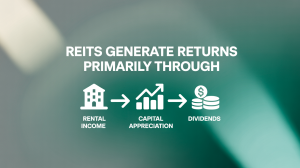
REITs in India: Invest in Real Estate Without Buying Property
REITs in India: Invest in Real Estate Without Buying Property
Real estate has long been a favorite asset class for Indian investors. But traditional property investment comes with high capital requirements, maintenance headaches, and low liquidity. Enter REITs—Real Estate Investment Trusts—an innovative way to invest in real estate without owning property.
Thank you for reading this post, don't forget to subscribe!REITs offer exposure to income-generating commercial real estate, like office spaces and malls, through small-ticket investments—just like buying a stock or mutual fund.
Let’s break down how REITs work, why they’re gaining traction in India, and how you can start investing.
What Are REITs?
A REIT (Real Estate Investment Trust) is a company that owns, operates, or finances income-producing real estate. It pools money from investors and invests in a diversified portfolio of commercial properties.
In India, listed REITs must:
- Invest at least 80% of assets in income-generating commercial real estate
- Distribute 90% of net distributable cash as dividends
- Be listed on stock exchanges for public trading
Examples of listed REITs in India:
- Embassy Office Parks REIT
- Mindspace Business Parks REIT
- Brookfield India Real Estate Trust
- India Grid Trust (InvIT – infrastructure focused)
Why Invest in REITs?
✅ Low Entry Point
Invest in commercial real estate with as little as ₹300–500 per unit.
✅ Regular Income
REITs pay out consistent dividends (quarterly/half-yearly) sourced from rental income.
✅ Liquidity
REITs are traded on NSE/BSE—buy or sell anytime like stocks.
✅ Diversification
Gain exposure to premium office spaces, business parks, and retail hubs across cities.
✅ Professional Management
Properties are managed by experienced real estate professionals ensuring high occupancy and maintenance.
✅ Tax Efficiency
Dividends are tax-free in the hands of investors (as per current tax rules, subject to conditions).
How Do REITs Earn Returns?

REITs generate returns primarily through:
- Rental Income: Leased commercial spaces with long-term contracts
- Capital Appreciation: Value of underlying properties may rise over time
- Dividends: 90% of income is distributed to investors
How to Invest in REITs
✅ Step 1: Demat Account
You need a demat and trading account—REITs are listed just like shares.
✅ Step 2: Choose Listed REITs
Research and compare REITs based on occupancy rates, rental yields, portfolio quality, tenant strength, and geographic spread.
✅ Step 3: Buy via Stock Exchange
Place buy orders through your broker like any equity security.
✅ Step 4: Track Performance
Monitor NAV, dividend payout, occupancy, and rental escalations periodically.
Real-Life Example: Urban Investor, Age 32
Rohit, a 32-year-old tech professional in Bengaluru, wants real estate exposure without buying physical property. He invests:
- ₹50,000 in Embassy REIT via SIP mode
- Reinvests dividends
- Monitors rental yields and market updates
- Uses REITs as a supplement to equity and debt in his asset allocation
Risks & Considerations
Market Risk: REIT prices fluctuate with real estate and broader market sentiment
Interest Rate Sensitivity: Rising interest rates can affect REIT valuations
Geographic & Tenant Concentration: Heavy reliance on few properties or tenants may be risky
Regulatory Changes: Changes in REIT taxation or real estate laws can impact returns
Tip: Read REIT annual reports and investor presentations to understand tenant mix and lease maturity profile.
REITs vs. Buying Property
| Criteria | REITs | Physical Property |
| Minimum Investment | ₹300–500 | ₹25–50 lakh+ |
| Liquidity | High (traded on stock exchange) | Low (long selling process) |
| Management | Professionally managed | Self-managed |
| Diversification | Across multiple assets | Usually one property |
| Income | Regular dividends | Rental income (inconsistent) |
| Costs | Low (no maintenance or stamp duty) | High (EMI, registration, upkeep) |
Conclusion
REITs are transforming how Indians invest in real estate. They offer a low-cost, liquid, and diversified way to earn steady income from premium commercial properties—without the burden of ownership.
If you’re looking to diversify beyond equity and debt, REITs are a smart, income-generating alternative that fits both conservative and growth-oriented portfolios.
Want to Explore REITs for Your Portfolio?
At Goodwill Wealth Management, we help investors evaluate REIT options and build a balanced portfolio with diversified real estate exposure.
Talk to our advisors and start your REIT journey with confidence—real estate returns, minus the real estate hassle.

